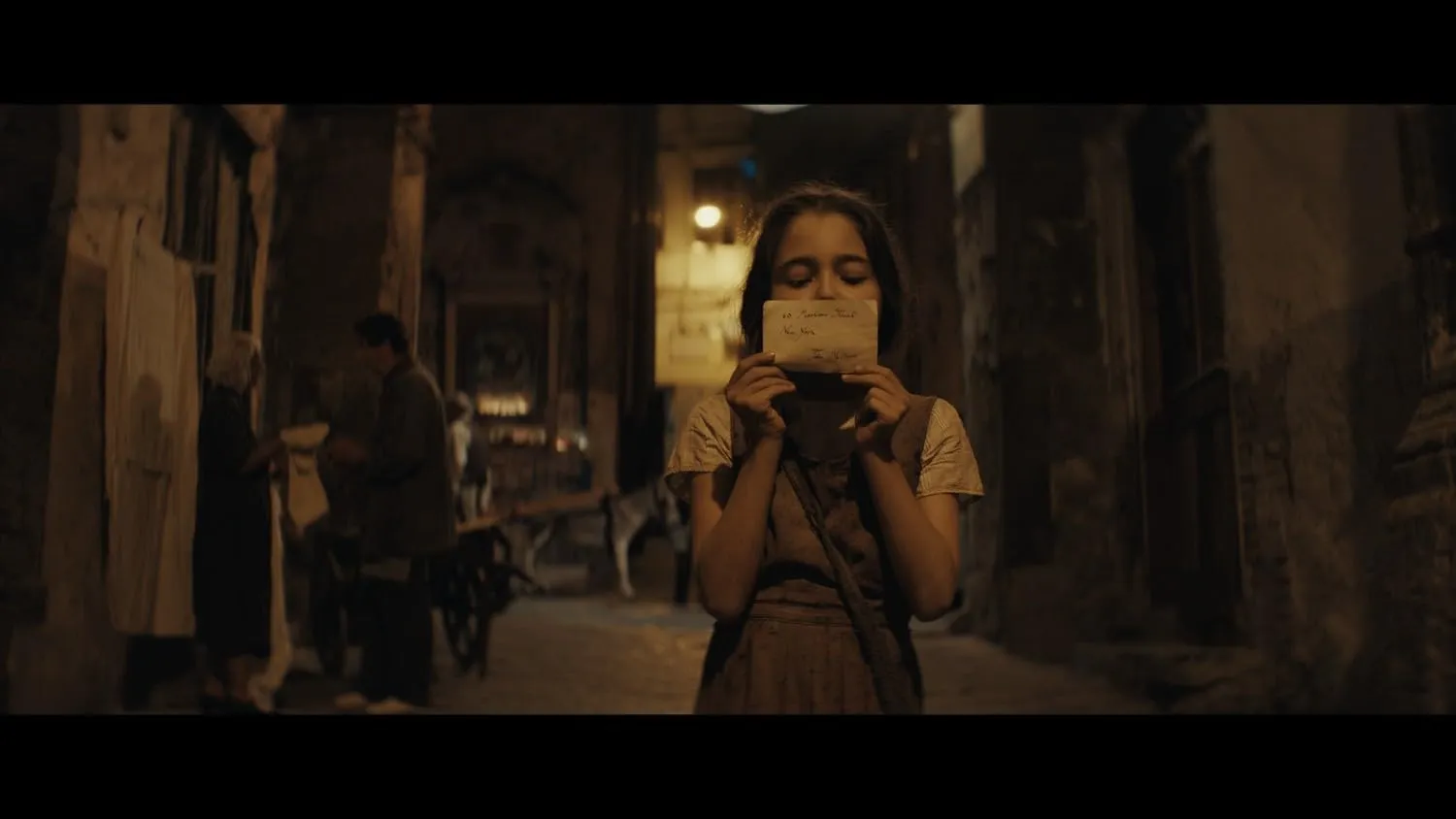In the ruins of postwar Naples, 1949 stands out as a crucible of survival when life emerges from the ashes of destruction. Celestina, an orphan, and her streetwise companion, Carmine, navigate a landscape rife with despair while also brimming with youthful vigour. Their bond, formed through adversity, encapsulates the essence of innocence amid chaos—a sad reminder of childhood’s ephemeral purity in a traumatized world.
Their disastrous stowaway adventure on the Victory steamship takes them into the immense unknown, a metaphorical ocean reflecting the stormy depths of the human psyche. As the children avoid the ship’s captain’s inebriated anger and deal with the sharp class disparity, the voyage becomes a liminal realm in which the limits of youthful innocence and the harsh realities of adult struggles blend. Each wave has existential weight, echoing the harsher realities of migration and identity.
The early excitement of the American Dream fades against a backdrop of retro-kitsch and disillusionment upon their arrival in New York. Celestina’s innocent mistake of associating the Statue of Liberty with the Madonna of Pompeii underlines the terrible irony of longing for a promised land that frequently leads to disappointment.
When they eventually meet Celestina’s sister, the narrative turns to a realm where familial bonds are tested against the harsh realities of long, posing fundamental concerns about belonging and the cost of dreams in a cruel world.
Shadows of Innocence: A Character Exploration
Celestina, portrayed with dramatic fragility by Dea Lanzaro, exemplifies youth’s resilience amid the ruthless backdrop of war-ravaged Naples. Orphaned and adrift, her motivations are driven by a strong desire for connection and belonging. Celestina’s development is marked by a gradual awakening to the harsh realities of the world around her as she navigates the dangerous waters of survival.
Lanzaro’s portrayal captures this progression, imbuing Celestina with a palpable blend of rebellion and vulnerability. Each glance, each timid step forward, reveals new layers of her character—an innocent soul forced into the complexities of life, where the line between hope and despair blurs. In her journey, we witness not just a child’s adventure but an exploration of existential themes: the search for identity in the face of chaos and the unsettling question of whether one can genuinely find home.
Carmine, given to life by Antonio Guerra, serves as both a companion and a guardian, embodying the street-smart resilience required for survival in their difficult surroundings. His character starkly contrasts Celestina’s innocence; he is pragmatic and frequently uses guile to navigate their world.
However, underlying his swagger is a youngster struggling with the weight of responsibility and the fear of loss. Guerra’s portrayal is marked by lively sincerity, capturing the essence of a childhood blighted by need. Carmine’s delicate moments show a deeper need for connection, reflecting the universal struggle of a young soul seeking refuge in an uncertain world.
The supporting characters, particularly Pierfrancesco Favino as Garofalo, add to the narrative’s tapestry with their various views. Favino’s portrayal of the Italian purser alternates between stern authority and paternal warmth, embodying the complexities of immigrant life. Garofalo’s interactions with the children highlight bigger themes of solidarity and compassion in the face of tragedy.
Other characters, ranging from the inebriated captain to the vibrant residents of Little Italy, serve as mirrors reflecting society’s complex struggles, each giving depth to the film’s exploration of human connection and the often painful journey toward belonging. Through their encounters, we are confronted with the darker realities of migration, the fragility of dreams, and the enduring strength of hope in the face of despair.
Navigating the Depths of Existence: Themes and Motifs
At the heart of Naples to New York is a profound exploration of migration and identity, with the immigrant experience serving as more than just a backdrop but also a vivid prism through which the narrative unfolds. The film poignantly contrasts Celestina and Carmine’s hopes with the harsh realities they face upon arrival in America. Their stowaway journey serves as a microcosm of the larger immigrant saga—one of aspiration but plagued by disillusionment.
The children’s first illusions of land bursting with possibility are rapidly dashed by meetings with brutal socioeconomic discrepancies, illustrating the often-overlooked complexities inherent in the search for a better life. This contrast encourages viewers to reflect on the existential question: What does it mean to be long, and at what cost is that long achieved?
The theme of childhood innocence is carefully woven throughout this tapestry of longing and loss. We witness a moving narrative about overcoming adult challenges via the eyes of Celestina and Carmine, who are both innocent and wise. Their connection emerges as a haven amid chaos, embodying a resilience that speaks to the tenacity of youth.
Their bond becomes a monument to the strength found in companionship as they confront survival challenges, suggesting that even in the darkest moments, the light of connection may guide one through the void.
However, the film does not shy away from criticizing the romanticized American Dream, exposing the contradiction between its sparkling surface and the harsh reality immigrants encounter. The colourful vision of New York, full of promise, is undermined by the dismal realities of exclusion and economic hardship.
The narrative demands a confrontation with the disillusionment that often comes with such dreams, as Celestina incorrectly associates symbols of American affluence with personal salvation. This critique resonates strongly in today’s setting, sparking reflections on the persistent socioeconomic inequities and the haunting question of whether the American Dream is a beacon of hope or a mirage that leads to despair.
Through these themes, Naples to New York becomes more than just a migration story; it is a meditative exploration of the human condition, inviting us to consider the complicated interplay between hope, identity, and the elusive desire for belonging.
Framing Dreams and Despair: Cinematic Style
Gabriele Salvatores’ directorial style from Naples to New York is a careful balance of homage and invention. The shadows of Federico Fellini’s original script loom large while allowing for a distinctly modern interpretation. Infusing the film with a blend of whimsical appeal and grim realism, Salvatores navigates this terrain with acute sensitivity.
His vision captures the essence of childish wonder while tackling the harsh realities of migration, creating a narrative that resonates emotionally and philosophically. The echoes of Fellini’s surrealism are palpable, but Salvatores avoids a blatant replica; instead, he utilizes his predecessor’s spirit to explore themes of displacement and identity through a new perspective.
Visually, the film is a beautiful tapestry woven with diverse colour palettes that reflect the characters’ emotional landscapes. The sun-drenched streets of Naples are ablaze with brilliant colours, embodying the warmth and resilience of its people. In contrast, the muted tones of New York suggest a sense of disillusionment and coldness.
This duality serves not only as a visual choice but also as a significant remark on the immigrant experience: the bright hopes of leaving are tempered by the heavy load of reality. Thanks to excellent production design, every frame becomes a dramatic device, and the bustling lanes of Naples and the huge avenues of Manhattan serve as more than just settings—they are characters in their own right, shaping Celestina and Carmine’s lives and destiny. The film invites viewers to reflect on the complexities of hope, loss, and the raw truths of human existence through this interplay of light and darkness.
Echoes of History: Cultural Context
Naples to New York resonates with the historical weight of a nation dealing with the scars of combat, set against the backdrop of post-war Italy. The year 1949 is more than just a date; it is a crucible of transformation, with the remains of war still embedded in the fabric of society. The rubble-strewn streets of Naples serve as a chilling reminder of catastrophe, shaping the minds of people such as Celestina and Carmine.
Their journey represents a generation caught between the ruins of its past and the uncertain promise of the future. In this light, the film becomes a meditation on resilience—the tenacious spirit of those who, despite the chaos, struggle to make relationships and find a glimmer of hope amid despair.
In the 1940s, when the immigrant experience was fraught with aspiration and estrangement, the narrative reflects the complexities of Italian-American interactions. Celestina and Carmine represent the dichotomy of cultural assimilation as they navigate their new world in New York, balancing the line between yearning for their hometown and the harsh realities of identity challenges in a distant land.
The film quietly examines the romanticized notion of the American Dream, exposing the frequently implicit prejudices and socioeconomic limitations that define the immigrant experience. It explores existential themes about belonging and the cost of assimilation, suggesting that one may lose sight of the essence of who they are in pursuing acceptance. Through these layers, Naples to New York conveys a migration story and inspires reflection on the larger human condition, echoing the struggles of many people seeking refuge and identity in an often uncaring world.
The Sound of Longing: Musical Score and Soundtrack
From Naples to New York, the musical soundtrack emerges as an essential undercurrent, threading through the narrative like a melancholy whisper, echoing the characters’ deepest struggles and hopes. Composed with acute sensitivity, the score goes beyond ordinary accompaniment, becoming an emotional channel heightening the film’s impact.
Each note appears to bear the weight of Celestina and Carmine’s journey, embodying their innocence while also alluding to the darker realities that lie ahead. Thematic motifs, which are frequently subtle yet filled with seriousness, reflect the fragility of childish dreams in a world fraught with doubt.
The soundtrack, which includes era-specific music, adds to the film’s emotional tapestry. Songs from the 1940s, mixed with modern echoes, serve as nostalgic markers and moving reminders of the cultural milieu that defines the immigrant experience.
As Celestina and Carmine travel through the lively streets of Naples and the harsh avenues of New York, the music evokes a sense of longing, capturing the essence of their dual existence. The score’s repetitive pulse pushes viewers to dive deeper, stimulating musings on the interplay of hope and despair and the haunting question of what it truly means to find one’s home in a world that sometimes feels alien.
A Tapestry of Dreams and Despair
From Naples to New York weaves a compelling narrative beyond the simple story of migration, diving deep into the human mind and the existential struggles accompanying the search for belonging.
The film’s emotional impact is palpable. It captures the delicate balance between hope and disillusionment, as exemplified by Celestina and Carmine’s innocent yet turbulent journey. Their adventures expose the harsher facts of the immigrant experience, where dreams frequently collide with harsh realities, sparking questions on identity, resilience, and the cost of aspiration.
The film offers a significant chapter to the continuing discourse in cinema about migration and the human condition through its exploration of these themes. It resonates with echoes of innumerable stories, reminding us that the journey to a promised land is uncertain.
Naples to New York urges viewers to confront their tales of displacement and belonging by embracing both the warmth of human connection and the shadows of despair, making it an important addition to contemporary cinematic storytelling.
The Review
Naples to New York
From Naples to New York is a moving exploration of migration, identity, and the bittersweet search for belonging. Gabriele Salvatores expertly mixes childhood innocence with the hard realities of the immigrant experience, resulting in an emotionally resonated narrative. While the film occasionally veers into romanticism, its emotional depth and excellent visual storytelling reflect the complexities of hope and despair. Finally, it stands as a significant contribution to the discussion of migration in cinema.
PROS
- Emotional depth and resonance in character journeys.
- Strong performances, particularly by Dea Lanzaro and Antonio Guerra.
- Rich visual storytelling with vibrant cinematography.
- Thoughtful exploration of migration and identity themes.
CONS
- Occasional idealism that may undermine darker themes.
- Pacing issues in certain segments, particularly in the New York section.
- Some historical anachronisms may distract from authenticity.
- Uneven character development in supporting roles.





















































